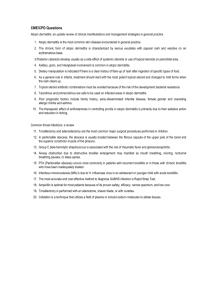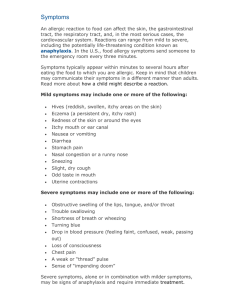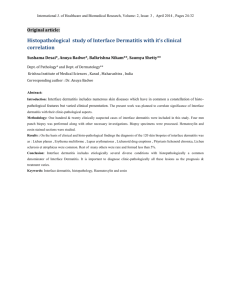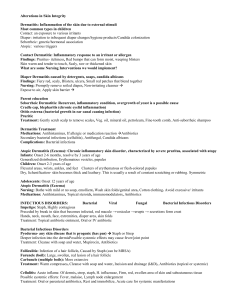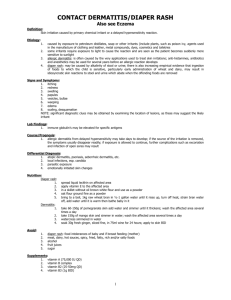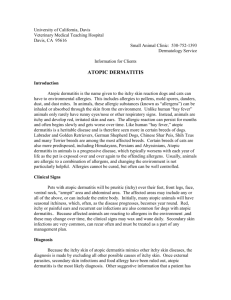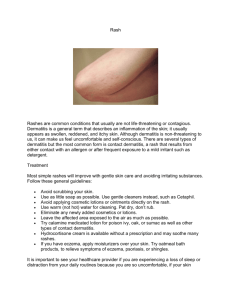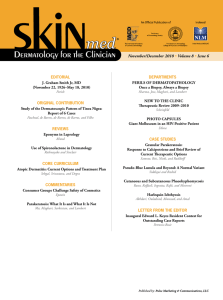Board Review
advertisement
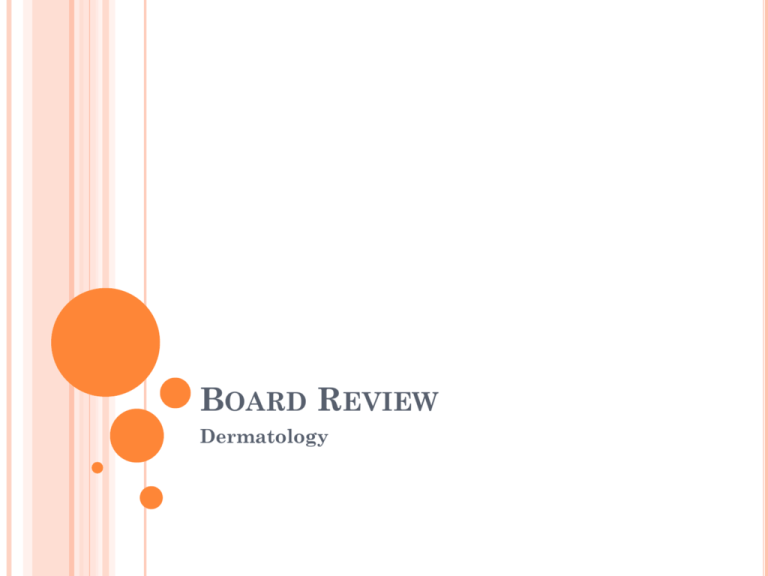
BOARD REVIEW Dermatology Psoriasis SILVERY SCALES COMMONLY HAVE THICKEND SKIN Found on extensor surfaces, scalp, butt AUSPITZ SIGN: when remove scale small pinpoint bleeding points Staph diaper dermatitis Complication of diaper dermatitis Thin walled pustules with erythematous base- rupture and leave a denuded area Cx: gram pos cocci Tx: oral and topical antibiotics Koebner Pnenomenon Lesions seen at areas of trauma Nummular excema Pruritic, round to oval shape red scaly patch Usually found on extensor thigh or abdomen. Commonly seen in children with atopic derm or keratosis pilaris Lack of central clearing! Pityriasis Alba Inflammation from atopic dermatitis – hypopigmented areas Most commonly seen on face or extremities Associated with other forms of atopy Pityriasis Rosea Herald Patch – oval pink lesion 5-10 days later the other lesion appear all over the body. Commonly seen on the trunk. Small round papules with scale “Christmas tree” Usually resolves in 4-6 weeks Seborrhea “cradle cap” Greasy Scaly Seen in hearbearing or intertriginous areas Tx: topical steroids, antiseborrheic shampoos Not that itchy. P Thumb sucking eczema From repeated wetting and drying Epidrmolytic Hyperkartosis Rare AD Form of ichthyosis Generalized thick, warty scales with intermittant blisters. Worse at extensor surfaces Histiologicallyballooning of squamous cells and microvesicles Auspitz Sign of Psoriasis Bleeding after removal of scales Atopic Dermatitis A: infantile Red, ITCHY, papules that ooze and crust Childhood – dry and very itchy Wrist, ankles, anticubital fossa, Popliteal fossa Can see with hyper or hypo pigmentation Rubber contact dermatitis T cell mediated immune reaction Seborrhea of scalp Tinea Corporis “Ringworm” Superficial fungal infection Annular lesion with central clearing. Vesicular border. Trichophyton tonsurans or Microsporum canis KOH Tinea Versicolor Multiple small oval scaly patches Commonly on upper back, trunk and upper ext. Pityrosporum org. Dark than other skin in non sun exposed areas and lighter in areas that are exposed. KOH – spaghetti and meatballs Tx; topical antifungals Discoloration may remain for months Diaper dermatitis Sparing intertirginous areas Treatment: barriers and moisturizer Watch for diaper rash that doesn’t go away!! Tinea Pedis “Athlete’s foot” Commonly seen between toes and soles, but can spread Tx topical antifungals Onychomycosisnail fungus - oral Erythema Multiforme Target Lesions Hypersensitivity reaction Symmetrical, any part of the body Can develop to bullae Causes: drugs, foods, immunizations Typically not that itchy Resolves 1-3 weeks Stevens-Johnson Erythema Multiforme major Involves mucus membranes and sloughing Monitor electrolytes Candida diaper dermatitis Satellite lesions Bright red, sharp borders KOH – budding yeast Commonly seen with antibiotic use Tx; topical antifungal Milia Rubra Sweat duct obstruction Commonly seen in infants – face and neck Worse in hot humid weather Tx: loose clothes, no greasy agents Infantile Acropustulosis Starts as papules and then progesses to pustules of vesiculopustules Common in AA males Seen on hands and feet Last 10 days then disappear, but will reappear a few weeks later. Resolves 2-3 yrs Unknown etiology Urticaria “Hives” Wheals VERY ITCHY IgE mediated Usually resolves within 24 hours Can progress to look like EM, or can spread to subcut tissues angioedema Serum Sicknesslike reaction 1. Urticarial lesions 2. Periarticular swelling 3. Extremity swelling Seen with URI or sulfa containing drugs Stocking glove angioedema Painful migratory periarticular swelling Morbilliform drug eruption Can look like viral exathem Macules and papules that usually starts on trunk or face Can see 5-14 days after starting the medication Henoch-Schonlein Purpura Palpable purpura Usually LE Small vessel vasculitis skin, GI, kidneys, joints Rash, abd pain, arthritis Commonly seen after viral illness Insect Bite Not to be confused with cellulitis Pruritc, nontender, and nonindurated. Insect Bites Flea bites – red itchy with central puncta
